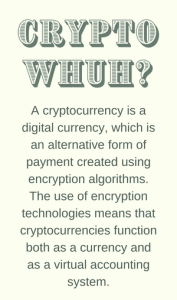 Never has a disclaimer been more important. Let me be clear, this article is in no way financial advice and does not necessarily reflect the views of HCPL. My degree is in English, not Economics or Finance, or Mathematics, or Accounting, or anything close to the knowledge people would need to responsibly manage their money.
Never has a disclaimer been more important. Let me be clear, this article is in no way financial advice and does not necessarily reflect the views of HCPL. My degree is in English, not Economics or Finance, or Mathematics, or Accounting, or anything close to the knowledge people would need to responsibly manage their money.
Additionally, I have no self-serving desire to tell you what you should or should not do with your money. SIDE NOTE / SHAMELESS PLUG: I do however always recommend becoming a “Friend of the library” – That’s just a great investment in your community and generally makes you a better person! That said;
This article is instead just a brief history of my attempts to understand cryptocurrency and a few things I think I picked up along the way. By the way, the library has an amazing collection of books and information on cryptocurrency, none of which I consulted before investing my own money or researching this article. Proceed at your own risk (and see a sampling of HCPL's collection below).
How it started
On April 20th, 2021 the online app, Venmo started offering its customers the ability to buy and sell cryptocurrency. I, like many of its users, had been using the app to send money back and forth with friends and family to cover dinner or other expenses when I didn’t have cash on me. Somewhere along the way, my balance worked its way up to just over a hundred bucks. Maybe it was the fact that it was just a number on my phone and not actual cash in my hand, but that $100 didn’t seem real, and as cryptocurrency seemed to be going up like a rocket, I justified thinking to myself that I would maybe start to understand this cryptocurrency everyone is talking about if I had some skin in the game. So, with a few clicks, I bought $100 worth of Bitcoin.
How it really started
“What is cryptocurrency?” Well, let's go back, way, way back. Somewhere around 6000 BC one of our ancestors traded some of the berries he had picked for one of those bird eggs his friend found. They both walked away happy, and this started a system of what we now call “Bartering.” Then, at some point, those shiny, gold rocks that everyone liked got made into coins. And those metal coins started trading hands. People liked the shiny metal stuff. It was valuable in both coin and nugget shapes and best of all – you could make stuff out of it! Those early folks weren't afraid to “put a ring on it!” And this went on for a while until Franklin Delanor Roosevelt (along with some other world leaders) took everyone off the Gold Standard in the early 1930s. That meant that the paper the money is printed on might not have much intrinsic value, but if everyone agrees a five-dollar bill is worth five dollars, then...it’s worth five dollars!
Most people don’t think about it much, but that stability is very important. No one wants to pick berries all day or work to get eggs from the angry bird only to find out that they can’t be traded for fish or warm pelts. So, governments and financial institutions got involved to “regulate” whatever form of currency was being used.
Is that explanation oversimplified? Sure, but it brings us to this, cryptocurrency is a digital currency, which is an alternative form of payment created using encryption algorithms.
Basically, big computers solve difficult math problems and when they do, they get “points” that are then saved and recognized by all other computers as valuable. And if everyone agrees that those “points” are currency, then they’re currency. If your local pizza shop says they will accept that digital coin, it’s as good as an actual coin.
I realize that this brings up a whole host of questions, most of which are too complicated to explain with shiny rocks and berries analogies, but I’m going to try, because, dang it, I love consistency. Let’s learn two things together.
- FIAT CURRENCY – This is paper money and coins. What they call “legal tender”, and it is backed up by and authorized by government regulation.
- REPRESENTATIVE MONEY – Money that is backed up by a physical asset (like gold) or another financial instrument like a check or a credit card.
So, which one is Bitcoin? Well, it’s not backed up by a commodity (Like gold) so it’s not representative money. It is backed by the faith of the investors or the agreement between parties, so it is like fiat currency in that way, but it is not backed up by the government. The U.S. Federal Reserve monitors cryptocurrency because it regulates the banks and other institutions that deal in cryptocurrency, but as of now, no government regulates cryptocurrency, and it is neither fiat currency nor representative money.
Bitcoin is just one type of cryptocurrency, but they are all based on Blockchain Technology (Remember those “encryption algorithms” we mentioned earlier?) So here is the last thing we need to learn for this story.
- BLOCKCHAIN TECHNOLOGY – This is a decentralized ledger system or database. In very basic terms, it is the bank where you put all your Bitcoins or other forms of cryptocurrency.
Now, with my Bitcoin in hand, or in my “protected encrypted digital wallet,” I could go to the open, unregulated market to see what its value was. How many shiny rocks or fish could I trade for my berries?
How it's going (or, more accurately, how it went)
So, what happened to my $100 Venmo investment into Bitcoin? Well, to my surprise, its value went up - way up! And in a short amount of time, I had doubled my money! Did I sell? No, of course not! I had Gordon Gekko greed, and I kept wondering how high “my precious” bitcoin might go. Some time went by, and it went down a little, and then it went down a lot, way down. And then it went down some more. As I write this today my $100 investment is now worth about $34.
Should I sell? Buy more while it’s low? Who knows? I do take some solace in that I now know more about cryptocurrency having had some skin in the game. I traded my berries for a little bit of education, and if I can learn from my mistakes then that knowledge is worth its weight in shiny rocks.




Add a comment to: From Berries to Bitcoin